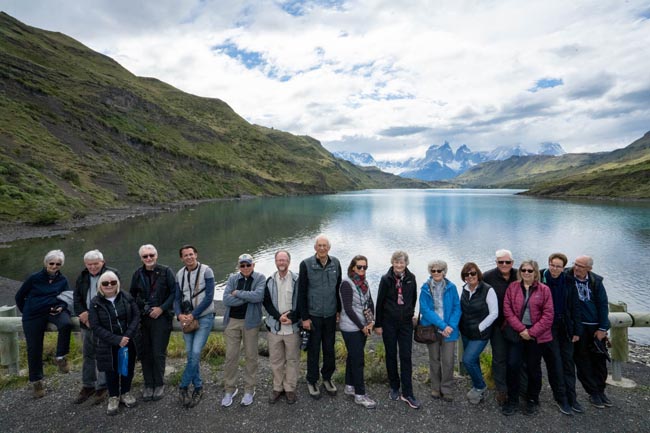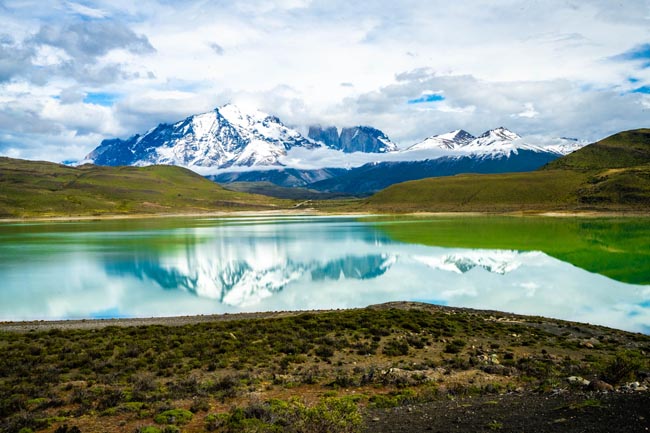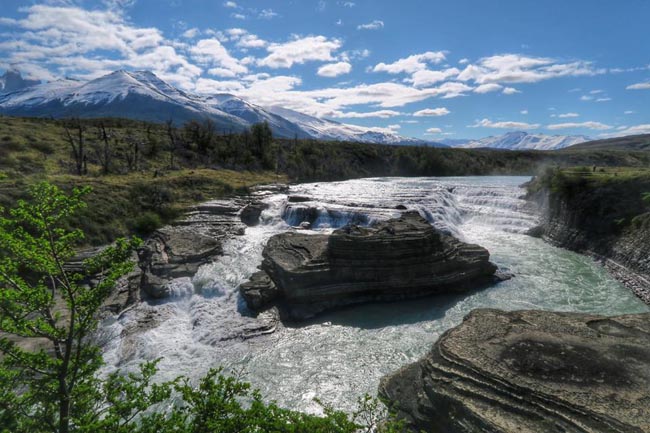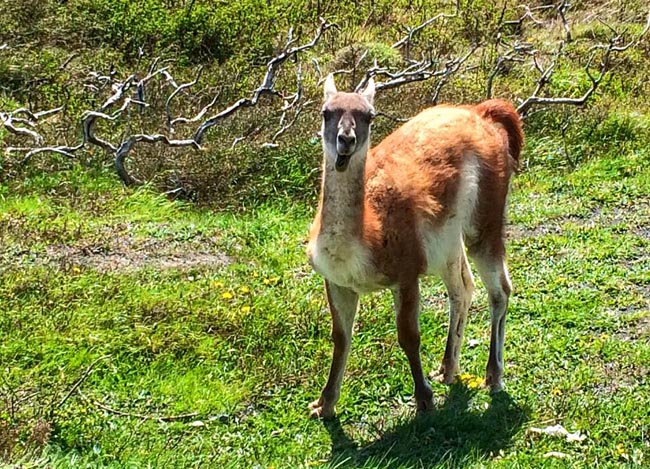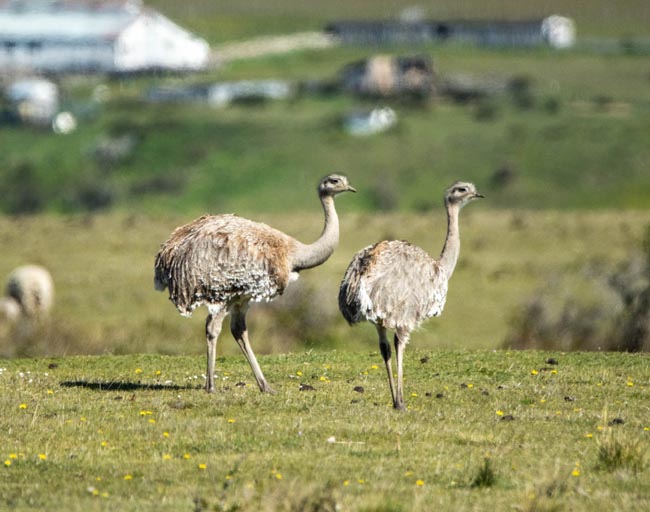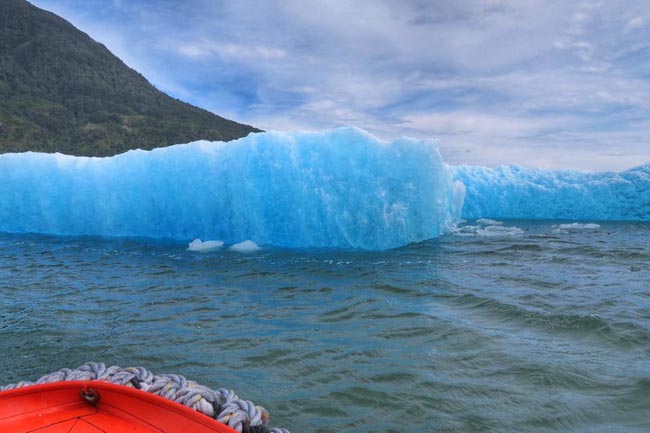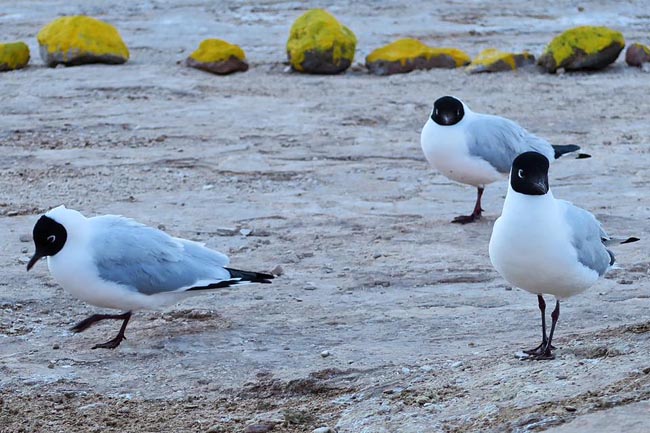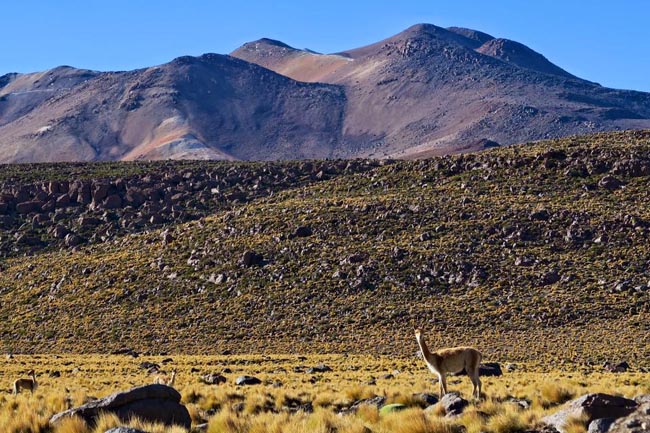Essential Chile Tour from Adventures Abroad: This thin strip of land that combines with Argentina to comprise the southern extremity of South America encompasses a greater scope than one might imagine from its inferior size.
From meandering through the world-famous wine-producing regions in the Central Valley, to standing agog in front of the Torres del Paine in the national park of the same name - often considered South America's best park - and from cruising through icy Chilean fjords, to marvelling at bubbling hotsprings in the Atacama Desert, we discover a country of uncommon natural breadth.
The lunar landscapes in the Valley of the Moon prove an otherworldly experience and our cultural exploration includes taking in ancient sites on the remote and mysterious Easter Island, exploring traditional mainland villages whose buildings are made from white volcanic stone and spending time in the major urban centres, like the lively Santiago.
Prices below are per person, twin-sharing costs in US Dollars (USD). Pricing does not include airfare to/from the tour and any applicable taxes. For single supplement rates and taxes (if any), please refer to below Prices & Dates table. For general information on flights to/from the tour, click here.
Your Travel and Accommodation Arranged For You
Tips Included for Driver, Restaurant Staff, Local Guides
Authentic Local Experiences With Lots Of Inclusions.
Select a date below to reserve your spot:
The above prices are subject to an additional $211 for taxes/fees levied on flights that occur as part of the tour. The internal airfares ARE included (any exceptions are listed in red below), but we list the taxes separately on your invoice as they are beyond our control and can change at any time.
$1000 per person deposit required due to nature of internal flights; additional $2000 pre-payment upon 'guarantee"
Optional Single Supplement: $2030 USD (number of singles limited).
This tour may require a mandatory single supplement charge of $1520 if you join our share program and we are unable to pair you.
Download Itinerary
Day 1 Arrive in Santiago, Chile
Today we arrive Santiago de Chile.
NOTE: This itinerary is based on air schedules that can change without notice. Though this program should provide a very good sense of how this tour will be accomplished, some adjustment/s may be required up to the time of departure.
Overnight in Santiago.
Included Meal(s): Dinner
Day 2 Santiago: Vina del Mar & Valparaiso
Today we travel to central Chile's Pacific coast and visit the colonial city of Valparaiso, an excellent example of late 19th-century urban and architectural development in Latin America. The route to Valparaiso takes us through the coastal plain and past Casablanca Valley, Chile’s fastest growing wine region. Valparaiso ('Paradise Valley') is one of Chile's most important seaports and an increasingly vital cultural center. The city was the first and most important merchant port on the sea routes of the Pacific coast of South America that linked the Atlantic and Pacific oceans via the Strait of Magellan. The importance of the vibrant seaport began to decline after the construction of the Panama Canal in the early 1900s.
Built upon dozens of steep hillsides overlooking the Pacific Ocean, Valparaiso boasts a labyrinth of streets and cobblestone alleyways, embodying a rich architectural and cultural legacy. Valparaiso is protected as a UNESCO World Heritage Site and is often considered to be one of Latin America's most intriguing urban areas. The majority of the houses were constructed between 1880 and 1940. The neighborhood’s economic and social lifeline was a system of funiculars that climbed the precipitous slopes, carrying people and goods like a series of elevators on wheels. In its heyday, the 'elevators' of Valparaiso had 31 station houses perched at points across the city’s steep terrain.
We'll stop at the heart of the historic quarter where we stroll the streets and enjoy a ride on one of the city's many elevators. Ascendor Artilleria, built in 1898, is one of the oldest still in operation and offers beautiful views of the coastline. The Cordillera funicular is situated on Cerro Cordillera, and was opened in the year 1887. This is the steepest and second oldest 'elevator' in Valparaiso.
Nearby along the coast we find the popular beachside resort of Vina del Mar. Vina del Mar has been nicknames the 'Garden City', and after some exploration here we return to Santiago.
Overnight in Santiago.
Included Meal(s): Breakfast and Dinner
Not finding what you're looking for?
Our specialists can take away the stress and create a private custom tour tailored to your exact interests and budget.
Day 3 Santiago & the Maipo Valley
Today we travel south of Santiago in order to visit the Maipo Valley, a scenic region just a short drive from Santiago. Maipo offers a delightful escape into the Chilean countryside; renowned for its vineyards, wineries, and stunning landscapes, it's a perfect destination for a day trip. one of Chile's most important wine-producing regions. This region is often described as the 'Bordeaux of South America', and during our time here we will visit one of the area's wineries for a tour and tasting. The valley is also characterized by rolling hills and the majestic Andes Mountains in the distance. The landscape is a mix of cultivated fields, orchards, and natural forests, creating a picturesque and diverse environment. The Maipo River, which flows through the valley, has played a crucial role in the region's development, providing water for irrigation and transportation.
At some point today, we will also visit Santiago's Plaza de Armas. As the midpoint of the Spanish settlement of 1541, the square was once a military training ground -- hence its name -- but with time it became the focus of Santiago's social and commercial life with some of the nation's most accomplished architecture.
Overnight in Santiago.
Included Meal(s): Breakfast and Dinner
Day 4 Santiago - Fly to Puerto Natales - Torres del Paine
This morning we will transfer to the airport for our flight to Puerto Natales, which sits alongside Ultima Esperanza Sound. Not far from Puerto Natales is the Mylodon Cave. This area became known to the world a little over 120 years ago when in 1895 the settler Eberhard Hermann visited the cave and found inside it the fur of a Mylodon, a large extinct sloth. We will make a stop here to walk the scenic path that brings us to the mouth of the cave.
From here we continue to the southern tip of the Andes in Chile, and Torres del Paine National Park, one of the most impressive sights in the Southern Hemisphere. The park encompasses ancient forests, glaciers, lakes, rivers and fjords, and fauna including guanacos, foxes, pumas and a diverse array of birds. The Torres del Paine (Towers of Paine) are spectacular granite pillars that soar almost vertically more than 2000m (6,000 feet) above the Patagonian landscape. The park in which the high peaks sit may be considered the finest national park in all of South America. With turquoise lakes, roaring waterfalls, rivers and creeks, dense forests and sprawling glaciers this is an unequaled destination.
Overnight in Torres del Paine National Park.
Included Meal(s): Breakfast and Dinner
Day 5 Torres del Paine National Park: Full Day of Exploration
Today we spend the entire day exploring Torres del Paine National Park.
We will travel by coach bus throughout all accessible regions of the park, stopping at various places of interest and scenic viewpoints. The photogenic panoramas are endless and, when the weather is clear, panoramas are everywhere. We will also have the opportunity to walk along some of the easy-going trails that afford expansive views of the mountains, waterfalls and glaciers for which Patagonia is famous. At Grey Glacier we will walk to the glacier viewpoint. A short walk in the heart of the park will bring us to Salto Grande, a spectacular waterfall on the Paine River. During our day we will also see the Cascada del Rio Paine (waterfalls), and Lago Pehoe (Lake Pehoe) in the heart of the park.
Some say Paine was the name of an early settler. Others say the name comes from an ancient Indian word meaning blue -- hearkening to the intense blue of the area's lakes. Wherever the name comes from or means, this is a spectacular park, comparable to Yellowstone or Yosemite in the US. Founded in 1959, Torres del Paine takes in 180,000 ha (450,000 acres). In 1978 UNESCO gave the park World Heritage status, recognizing it as a biosphere especially worthy of international recognition.
The park is part of the Paine Massif, which lies inside the continent from, or east of, the high central Andean spine. The massif are medium high mountains emerging suddenly from the plains of the Patagonian steppes. The mountains are granite, capped by crumbly sedimentary rock that used to lie on the valley floor. Before the Chilean government acquired the park, it belonged to ranchers who overgrazed and also burned down forests to increase pasture area. The glaciers of the park are in quick retreat--up to 17 m (56 ft) a year for the last 100 years, creating a fascinating study of plant succession and soil build-up from bare rock to forest. The flora of the park ranges from grassland to southern beech forests. Many parts of the park were too remote for the cattle ranchers, and exist today in a pristine state. The animal stars of the park are the Guanacos -- wild South American cameloids, related to the domesticated llama and alpaca -- and the Rheas, an ostrich-like bird. Native peoples hunted both across the plains, using every part for food and shelter. When the Europeans came, the Guanaco were slaughtered to make way for cattle and almost became extinct.
Overnight in Torres del Paine National Park.
Included Meal(s): Breakfast and Dinner
Day 6 Torres del Paine National Park - Punta Arenas
This morning we depart Torres del Paine and travel back to Punta Arenas.
Upon arrival in Punta Arenas we will make a short visit to the Municipal Cemetery, a fascinating place to stroll around due to its immaculately trimmed cypress trees and tree-laced pathways. The cemetery is resting place of pioneers, immigrants and families of diverse nationalities that left their mark in the colonization and development of this isolated part of the world.
Overnight in Punta Arenas.
Included Meal(s): Breakfast and Dinner
Day 7 Punta Arenas - Fly to Puerto Montt - Puerto Varas
This morning we fly to Puerto Montt. We then drive the short distance to Puerto Varas, the main gateway to the southern Lake District. Puerto Varas is one of southern Chile's most important cities with a spectacular setting at the north end of the Golfo de Reloncavi. The area around Puerto Varas is a region of spectacular lakes and mountains.
Overnight in Puerto Varas.
Included Meal(s): Breakfast and Dinner
Day 8 Puerto Varas Area: Osorno Volcano / Lago Todos los Santos
Today’s touring takes us along the shore of Lake Llonquihue to the Petrohue waterfall (Salto del Petrohue), an amazing series of oddly twisting water chutes. These chutes were formed by a crystallized black volcanic rock that is particularly resistant to erosion. The water at Rio Petrohue is bright green due to the presence of algae. On a clear day this drive is spectacular with the snow-capped peak of the Osorno Volcano looming above us.
From the town of Petrohue we take a catamaran ride on the azure-blue waters of Lago Todos los Santos to the town of Puella, a small village that serves as a stopping point on the route to Argentina. We will spend some time here enjoying the beautiful setting and taking a break for lunch. The Cascada de Los Novios (waterfall) is a just short walk from the village. We then enjoy our return lake crossing and continue back to Puerto Varas.
Overnight in Puerto Varas.
Included Meal(s): Breakfast and Dinner
Day 9 Puerto Varas - Fly to Balmaceda - Puerto Chacabuco
Early this afternoon we fly to Balmaceda from Puerto Montt. Balmaceda is just a small village situated to the west of the Andes, and from here we drive to Puerto Chacabuco and the Hotel Loberias del Sur. Our route takes us along part of the Austral Road, which goes through Llanquihue and Palena provinces on the side of the continent, up to the Aysen region passing by the beautiful city of Coyhaique.
On the journey to the hotel you will have the opportunity to appreciate a small sample of the astonishing variety of landscapes found at this latitude.
Overnight in Puerto Chacabuco.
Included Meal(s): Breakfast and Dinner
Day 10 Laguna San Rafael & San Rafael Glacier Discovery
Today we will enjoy an unforgettable trip on board a large catamaran that will take us through islands, channels, and fiords until we reach the Laguna San Rafael. The main attraction here is the San Rafael Glacier and the peacefulness of the San Rafael lagoon. The lagoon is located on the south side of the Moraleda Channel, right at the foot of the Northern Patagonian Ice Field, with San Rafael Glacier flowing into it.
When near the face of the glacier we will board zodiacs in order to get in closer contact with the San Rafael glacier, snowdrifts and a number of floes moving around. This is a truly spectacular experience. At the end of the excursion you will have the chance to enjoy a ‘whisky on the rocks’ made with ice cubes that are more than 20,000 years old! We will stay in the area of the lagoon for +/- 2 hours before returning to Puerto Chacabuco in time for dinner.
Overnight in Puerto Chacabuco.
Included Meal(s): Breakfast, Lunch and Dinner
Day 11 Aiken del Sur Private Park Nature Walk
This morning we travel by bus to Aiken del Sur Private Park. This park offers pure natural beauty on the shores of Lago Riesco. The crystal clear waters of the lake have a surface of 14 sq km. There is also a waterfall 22 meters high, native woodlands with perennial species, annual plants, moss and liverworts, widespread prairies where aged myrtles and tepa trees mix together; taro and mallin plants, and swamp lands.
The small Visitors' Center holds some interactive exhibitions providing information about the local flora, fauna and anthropology. From here we will take an easy walk (approx 1.5 hours +/-) along a scenic trail complete with catwalks, bridges, observatory points, and resting places that give information on the bio-geographical history of each place. We will enjoy the wonderful scenery of the lake, river and hills that make up the Andes mountain range in Northern Patagonia. You will also have the opportunity to hear the singing of local birds such as the Chucao and Hueta.
At the end of our walk we will enjoy a traditional Patagonian lamb barbeque for lunch (vegetarian options available). After lunch you may relax or enjoy another easy walk along one of the footpaths in the park.
Overnight in Puerto Chacabuco.
Included Meal(s): Breakfast, Lunch and Dinner
Day 12 Balmaceda - Fly to Calama - San Pedro de Atacama
Today we fly north to Calama (via Santiago) in the high Atacama Desert, the driest place on earth. On arrival we transfer to San Pedro de Atacama, elevation 2300 m (7,600 ft). Northern Chile is home to the world's most arid desert and its salt flats, hot springs and geysers as well as large deposits of copper and other minerals, Calama and other parts of the altiplano. This region also boasts fertile ravines and oases, inhabited by some of the country’s native peoples. Both Incan and Spanish influences can be seen in its villages, and evidence of human existence in this area dates back over 10,000 years. No significant precipitation has been reported here since the Spanish colonial period.
Overnight in San Pedro de Atacama.
Included Meal(s): Breakfast and Dinner
Day 13 Atacama Area: Salar de Atacama / Lago Chaxa / Toconao / Tulor & Quitor
We start our touring today with a visit to the Salar de Atacama, the world's largest salt lake. Rich in minerals, including borax and lithium, this salt lake is home to flamingos and many other bird species. Salar de Atacama is formed by waters flowing down from the Andes that, unable to escape from the basin, are forced to evaporate, leaving salt deposits on the earth. In some areas, lagoons peek out from under the crust, such as at Laguna Chaxa. At Lago Chaxa, part of the Reserva Nacional de los Flamingos, one often can get quite close to flamingos in their natural habitat.
From here we travel to the small colonial town of Toconao. The material of choice here is volcanic rock for both local crafts and the town church (1744) and San Lucas bell tower (1750). The church and houses in this picturesque village are built of bricks of the local white volcanic stone. You will have some free time here to wander the small streets and explore this quiet location.
We later return back to San Pedro for lunch and some free time before heading out again in the afternoon. This afternoon we will visit Tulor, a 2,800-year-old site where evidence of the earliest habitation in the region was found. Located in an ancient oasis once supported by the San Pedro River, Tulor Village is one of the most important ancient villages in the Atacama Desert. We will also visit the fort of Quitor (Pukara de Quitor). The Atacameño people built this Pukará in order to defend themselves from Pedro de Valdivia and the Spanish in northern Chile. This pre-Columbian archaeological site overlooks the valley of the river San Pedro and was designated a national monument in 1982.
Overnight in San Pedro de Atacama.
Included Meal(s): Breakfast and Dinner
Day 14 Atacama Area: El Tatio Geysers / Valley of the Moon
We leave the hotel early this morning before sunrise and travel northeast to see the spectacular geysers of El Tatio (elevation 4400m / 14,500 ft) located within the Andes mountains. We arrive at the site in time to watch the sunrise over the mountain. Here the super-heated water gurgles in the frozen ground and emerges violently as steam in over 100 geysers, boiling pools, and fumaroles. El Tatio is the largest geyser field in the southern hemisphere and the third largest in the world.
From here we continue to explore the beauty of this region of the Andes. If lucky we will have some great photo ops of vicuna along our route. We will also stop in the tiny village of Machuca. The small lakes and lagoons in the area are home to a number of indigenous bird species including the Andean Goose and Giant Coot.
We will return back to San Pedro for lunch before heading off again in the early evening to the Valley of the Moon. You will be wowed by the lunar-like landscape of the valley, which lies in the Salt Mountain Range. We will explore its many geological formations, from canyons to caves to depressions, and learn about the physical history of the area. From atop a sand dune you will be provided with some unique panoramas. Just prior to dusk we drive to the upper ridge of the Valley of the Moon to see the sunset in this bizarre lunar landscape formed by erosion of the salt mountains. Light reflecting off the salt crystals is an eerie sight.
We then return back to San Pedro after sunset.
Overnight in San Pedro de Atacama
Included Meal(s): Breakfast and Dinner
Day 15 Atacama - Fly to Santiago
Today we drive to Calama for our flight back to Santiago. Depending on today's flight schedule, there may be some free time in San Pedro de Atacama in the morning, or in Santiago in the afternoon.
Overnight in Santiago.
Included Meal(s): Breakfast and Dinner
Day 16 Santiago - Fly to Easter Island
Today we fly from Santiago to Easter Island.
Upon arrival at Mataveri Airport we see the first of Easter Island's famous Moai, or stone statues. Hanga Roa, the capital, is where most of the island's population of about 5,500 lives. Typically South Pacific in appearance, the pace in the village is typically slow.
Easter Island is over 3200 km from the nearest population center (Tahiti and Chile), making it one of the most isolated places on Earth. This triangle of volcanic rock in the South Pacific is best known for the giant stone monoliths, known as Moai, that dot the coastline. Almost 900 giant stone figures dating back many centuries reveal their creators to be master craftsmen and engineers. These stone figures are distinctive among other stone sculptures found in Polynesian cultures. There has been much speculation about the exact purpose of the statues, the role they played in the ancient civilization of Easter Island and the way they may have been constructed and transported.
The early settlers called the island "Te Pito O Te Henua" (Navel of The World). Admiral Roggeveen, who came upon the island on Easter Day in 1722, named it Easter Island. Today the land, people, and language are all referred to locally as Rapa Nui.
Overnight on Easter Island.
Included Meal(s): Breakfast and Dinner
Day 17 Easter Island: Full Day of Exploration / Rano Kau & Orongo Village
Today we will start our touring with a visit to Ahu Akivi. Restored in the 1960’s, Ahu Akivi has seven standing moai, and is the only ahu with moais that appear to be looking out towards the ocean. All other moai on the island face inland. We then make a stop at Puna Pau. Puna Pau is a small extinct volcano whose name means ‘dry spring’. What is most important today is that Puna Pau volcano’s crater was the quarry from where the stone needed to build pukaos, or moai headdresses, was taken. The red volcanic rock found here is soft and easy to carve, and it has a high iron content, which gives it its characteristic reddish color.
At Ahu Vinapu we see the incredible stone walls similar to those built by the ancient Incas; the architecture of these walls is sometimes used as an argument to support the theory that the early islanders came from South America.
We will take a break for lunch in the center of Hanga Roa before heading to the southernmost volcano of the island, Rano Kau. From here we will have an opportunity to see most of the island as well as its reed-covered lake. On the west side of the slopes you have an impressive view of the islets Motu Nui, Motu Iti and Motu Kao-Kao. The main feature on Rano Kau is its rebuilt ancient ceremonial village of Orongo. In primitive times it was used for the traditional egg-ceremony, taking place year after year to choose the religious head of the island. The site is full of petroglyphs representing Tangata Manu (birdman) and the god Make-Make.
Overnight on Easter Island.
Included Meal(s): Breakfast and Dinner
Day 18 Easter Island: Full Day of Exploration / Rano Raraku
Today we start our full day of touring with a visit to the spectacular Rano Raraku quarry, a highlight of any visit to Rapa Nui. This location is a classic symbol of the island and the original factory of the moais. Here we will see the dozens of gigantic statues that cover the inner and outer slopes of the volcano. We so many statues in situ, we are able to admire them in different stages of production, from carving in the rock to upright position and lying face down on their intended road to their platforms.
From Rano Raraku we proceed to Ahu Tongariki, the largest Moai site of Easter Island. Here we see 15 moai lined up, including the largest moai ever erected on the island. The Moai (with their pukao) were toppled in the 17th century during a tribal war. Fortunately none of them were broken, and they remained on the ground until the great earthquake of 1960. At that time a large tsunami took the fallen statues and the pukao and scattered them further inland leaving them a couple of hundred meters from their original location.
We continue along the south coast, stopping at Ahu Akahanga, a large ahu (platform) with four big fallen statues. According to legends, the tomb of the first king of the island is in this area. We then visit Vaihu, another ancient site in ruins.
This afternoon after lunch we head across the heart of the island to Papa Vaka, located on the north coast. Papa Vaka is an archaeological site located on the island’s north road, and is characterized by its numerous petroglyphs (designs carved into rock) with motifs related to the sea and fishing.
Our last stop today will be at the beautiful archaeological zone of Anakena where we see the standing moai. We we will spend some time at the beautiful white sandy, coconut-palm lined beach. This setting is decidedly Polynesian, and a great place to end our day.
Overnight on Easter Island.
Included Meal(s): Breakfast and Dinner
Day 19 Easter Island: Day at Leisure
Today is free to explore the island on your own. Perhaps you may want to return to the beach, enjoy a short hike, stroll the quiet streets of Hanga Road with the many shops, cafes, and artesan markets.
Overnight on Easter Island.
Included Meal(s): Breakfast and Dinner
Day 20 Easter Island - Fly to Santiago
Today we travel back to Santiago. Depending on the time of our flight, you may have some free time today in either Easter Island or Santiago.
If we arrive late in Santiago, we will likely overnight at an airport hotel.
Overnight in Santiago.
Included Meal(s): Breakfast and Dinner
Day 21 Departure
Departure from Santiago.
BUEN VIAJE!
Included Meal(s): Breakfast
Inclusions
Breakfast and dinner (hotels & local restaurants) daily.; some lunches per the itinerary. All transport, sightseeing and entrance fees for sites noted as 'visited' in the detailed itinerary. Gratuities for boat crew, local guides, drivers, restaurant staff, porters. Domestic flights via local scheduled carriers as per the itinerary. Airport transfers for land & air customers and for early arriving / late departing land & air customers who book their extra hotel nights through us.
Exclusions
International airfare to/from the tour. Tour Leader gratuities, lunches, drinks, personal items (phone, laundry, etc), international (if applicable) and domestic air taxes, visa / arrival / departure fees, excursions referenced as 'optional'. Airport transfers for Land Only customers. Our post-reservation trip notes offer further guidance on optional meal costs, shopping, and visas.
Seasonality and Weather
Weather conditions can vary greatly from place to place. Much of our time is spent in the south where conditions can be very changeable at any time of year. We visit in the Austral summer (Nov-Mar), when Santiago and Easter Island are hot and Patagonia is at its warmest. That said you must also be prepared for cold, windy, possibly rainy conditions.
Transport and Travel Conditions
Ground transport by private air-conditioned motor coach, 24-36 seats depending on ultimate group size (see 'group size'). Though we will have some full bus days, road travel is not particularly arduous as roads are generally in good condition, though a little winding on some stretches. Internal flights via domestic carriers.
Our difficulty "Level 1" rating for this trip refers to the comfort of our transport and accommodation and the lack of physicality in terms of walking. That said, this is a busy program with lots of moving around and full days of travel and sightseeing. You must also be prepared for the possibility of some early starts, walks at various points of interest and some short walks to dinner. Our sightseeing in towns and cities, as well as national parks, are also conducted on foot at a leisurely pace. Though we try to minimize long road journeys by utilizing internal air connections, we still have some full days of travel. Related to air travel, you must be prepared to manage your own luggage at airports. This tour does not travel to any region considered "high altitude."
Am I suitable for this tour? Please refer to our self-assessment form.
Activity Level: 1
No particular physical activity is involved other than town/city walks and short walks to dinners and sites of interest, some of which are large.
To learn more about the Activity levels, please visit our tour styles page.
Accommodation
Well-located, air- conditioned / heated, mid-range hotels and inns (3-star) used throughout. All hotels have en suite toilet and bath, though some may have shower only. Porter service is usually available (see 'inclusions') though you should be independent with your luggage, especially at airports. Single rooms are limited and likely smaller than twins.
Staff and Support
Tour Leader and local step-on guides, driver. Catamaran crew and naturalist guides.
Group Size
Maximum 18 plus Tour Leader
Regions visited: South America
Countries visited: Chile
*The red tour trail on the map does not represent the actual travel path.
The following is a list of sample hotels at some locations included on this tour. The hotels shown here are meant to provide a general sense of the standard of hotel we usually aim for; they are not necessarily confirmed for your chosen departure.











Hotel Loberias del Sur has a direct relationship with two great attractions ... visitors to Chilean Patagonia: the “Chaiten” Catamaran, a vessel that specializes in making trips to the Laguna San Rafael, and Aiken del Sur Park, a 300-hectare nature reserve.
Having this infrastructure lets us offer a product with the highest international quality standards, with a “4 Star Superior” rating to back us up. This guarantees that you will find with their service, the rest and tranquility you need to enjoy the nature of Chilean Patagonia.








